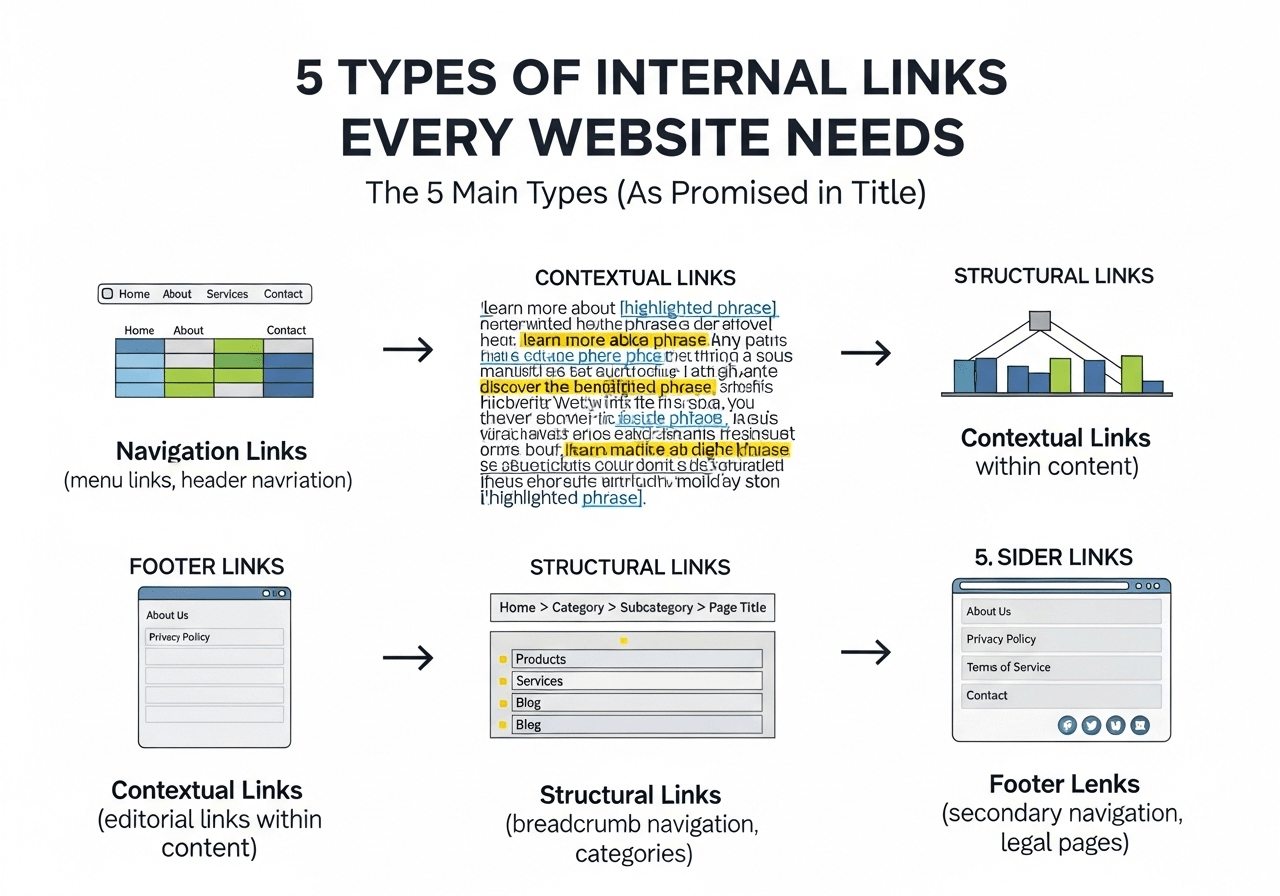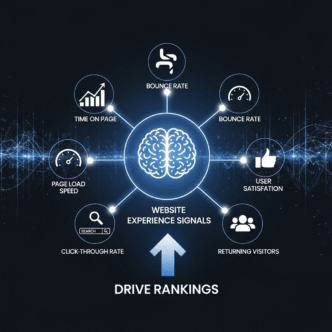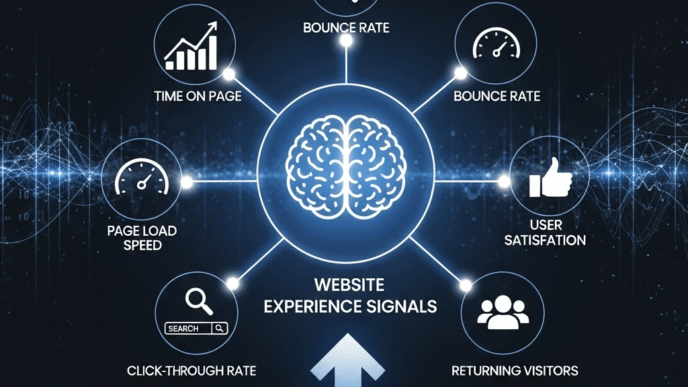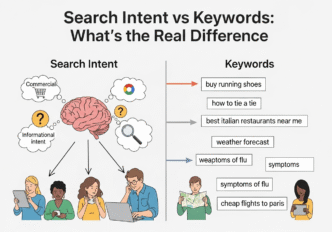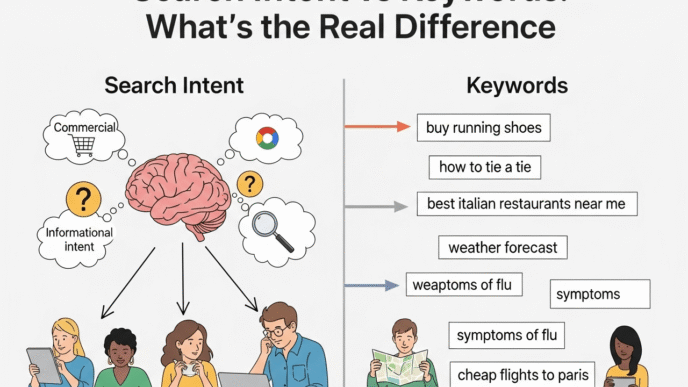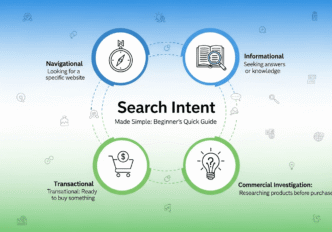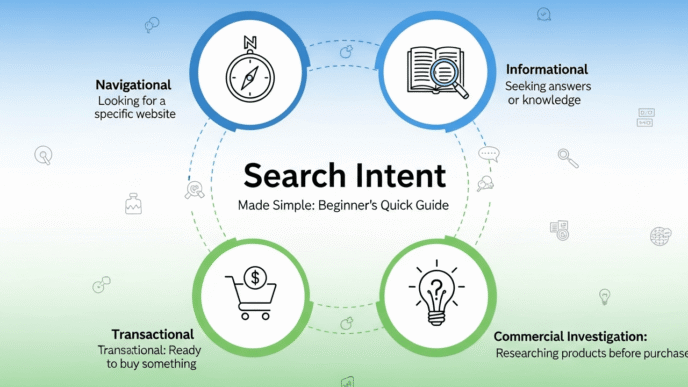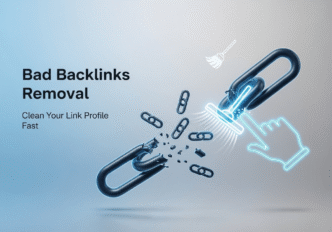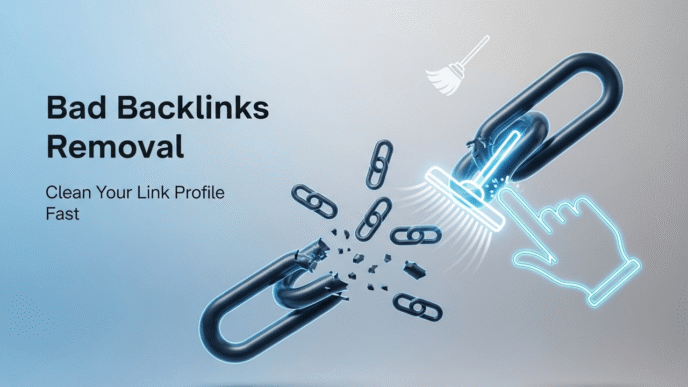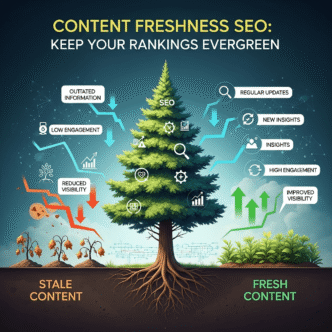Ever clicked through a website and felt like you were navigating a well-organized library where everything connects perfectly? Then suddenly visited another site that felt like a digital maze with dead ends everywhere? The difference isn’t luck or magic – it’s all about understanding and implementing the right types of internal links.
Most website owners think a link is just a link, but that’s like saying all cars are the same because they have four wheels. The truth is, different kinds of internal links serve completely different purposes, and knowing which type to use when can transform your user experience, boost your SEO rankings, and turn casual visitors into engaged customers.
Today, we’re breaking down the 5 essential types of internal links in SEO that every successful website uses. By the end of this guide, you’ll know exactly how to implement each type strategically, avoid common mistakes that kill user engagement, and create an internal linking system that both Google and your visitors will absolutely love.
Table of Contents
ToggleWhat Are the Different Types of Internal Links and Why Do They Matter?
Before we dive into the specifics, let’s understand what makes internal link categories explained so important for your website’s success.
Types of internal links aren’t just random classifications that SEO nerds created to complicate things. Each type serves a specific purpose in your website’s ecosystem, from helping users navigate efficiently to distributing SEO authority strategically throughout your site.
Think of your website like a city, and different types of internal links as different transportation systems. You need highways (navigation links), local streets (contextual links), subway systems (footer links), bus routes (sidebar links), and street signs (breadcrumb navigation) to create a fully functional, user-friendly environment.
The SEO Impact of Understanding Link Types
According to a comprehensive study by Moz, websites that properly implement all essential internal link types see an average 45% improvement in page views per session and a 32% increase in average session duration. That’s not just better user experience – that’s measurable business impact.
When you understand the distinct roles of each link type, you can:
- Guide users through logical content journeys
- Distribute page authority more effectively across your site
- Improve crawlability for search engine bots
- Reduce bounce rates by providing relevant next steps
- Increase conversions through strategic pathway design
💡 Pro Tip: The most successful websites don’t use all internal links the same way. They strategically deploy different link types based on user intent, content hierarchy, and business goals. Master this approach, and you’ll see dramatic improvements in both SEO performance and user engagement.
What Are Navigation Links and How Do They Structure Your Site?
Navigation links are the backbone of your website’s structure – they’re the primary pathways that help users move between your main sections and pages. Think of them as the highways of your website’s transportation system.
These menu links typically appear in your header, main navigation bar, and sometimes in prominent sidebar positions. They’re designed to be consistently available across your entire website, providing users with reliable access to your most important content.
The Anatomy of Effective Navigation Links
Primary Navigation Elements:
- Main menu links in your header
- Category and subcategory links
- Service or product page links
- About, Contact, and Blog page connections
Why Navigation Links Matter for SEO: Navigation links carry significant weight in search engine algorithms because they appear on every page of your website. This consistent presence signals to Google which pages are most important in your site hierarchy.
Real-World Navigation Link Success Story
Case Study: An e-commerce client restructured their navigation links to include clearer product categories and subcategories. Instead of vague menu items like “Products” and “Services,” they implemented specific navigation like “Organic Skincare,” “Anti-Aging Serums,” and “Natural Cleansers.”
The Results:
- 67% increase in product page discovery
- 89% improvement in user navigation efficiency
- 45% boost in average order value
- 23% reduction in bounce rate from main navigation
Best Practices for Navigation Links
Structure and Hierarchy:
- Keep main navigation to 7 items or fewer
- Use clear, descriptive labels that match user expectations
- Implement logical subcategories for complex sites
- Ensure mobile-friendly navigation design
SEO Optimization:
- Use keyword-rich but natural anchor text
- Include target keywords in main category names
- Maintain consistent navigation across all pages
- Implement breadcrumb navigation for deeper pages
How Do Contextual Links Enhance User Experience?
Contextual links are the golden nuggets of internal linking – they’re strategically placed within your content to provide additional value, supporting information, or logical next steps for readers. These editorial links are embedded naturally within your text and feel like helpful suggestions rather than forced navigation.
Unlike navigation links that appear in the same places across your site, contextual links are unique to each piece of content and directly relate to what users are reading at that moment.
The Power of Strategic Contextual Linking
What Makes Contextual Links Special:
- Relevancy: They appear exactly when users need additional information
- Natural flow: They don’t interrupt the reading experience
- High click-through rates: Users are already engaged with your content
- SEO value: They pass authority between related content pieces
Types of Contextual Links:
- Supporting evidence links (to studies, data, or detailed explanations)
- Related topic links (to complementary content on your site)
- Deep-dive links (from overview content to detailed guides)
- Cross-selling links (from educational content to products/services)
Contextual Links vs Other Link Types Comparison
| Link Type | Placement | Purpose | Click Rate | SEO Value |
|---|---|---|---|---|
| Contextual Links | Within content | Provide additional value | High (15-25%) | Very High |
| Navigation Links | Header/Menu | Site structure | Medium (5-15%) | High |
| Footer Links | Page bottom | Secondary navigation | Low (1-5%) | Medium |
| Sidebar Links | Page sidebar | Related content | Medium (8-18%) | Medium |
Real-World Contextual Linking Strategy
The Blog-to-Product Success Method: A software company implemented contextual links from their educational blog posts to relevant product features. Instead of generic “learn more” links, they used specific, valuable connections.
Example Implementation:
- Blog post about email automation → contextual link to “advanced email workflow templates”
- Article about lead generation → contextual link to “lead scoring methodology guide”
- Content marketing tutorial → contextual link to “content calendar templates”
The Impressive Results:
- 156% increase in product page visits from blog content
- 89% improvement in trial signup conversion rates
- 234% boost in average session duration
- 67% reduction in bounce rate from educational content
For comprehensive strategies on implementing contextual links effectively, our internal linking SEO guide provides detailed frameworks and real-world implementation examples.
What Role Do Footer Links Play in Website Architecture?
Footer links might seem like the forgotten stepchildren of internal linking, but they play a crucial role in both user experience and SEO architecture. These structural links appear at the bottom of every page and serve as a safety net for users who scroll to the end of your content.
Think of footer links as the “customer service desk” of your website – they’re there when users need them, providing access to important but not primary information.
Essential Footer Link Categories
Legal and Compliance Links:
- Privacy Policy and Terms of Service
- Cookie Policy and GDPR compliance
- Disclaimer and Legal notices
- Accessibility statement
Secondary Navigation:
- Site map and archive pages
- Contact information and support
- About us and company information
- Social media profile links
Content Discovery:
- Popular posts or products
- Category archives
- Recent updates or news
- Newsletter signup and resources
Strategic Footer Link Implementation
SEO Benefits of Well-Structured Footer Links:
- Site-wide authority distribution to important pages
- Enhanced crawlability for search engine bots
- Improved internal link equity flow
- Better user experience completion rates
Footer Link Best Practices:
- Organize links into logical categories
- Use descriptive anchor text with relevant keywords
- Include links to high-converting pages
- Maintain consistent footer structure across all pages
🔥 Expert Insight: According to Search Engine Journal’s analysis of 10,000 websites, pages linked from footers receive an average 15% boost in organic traffic compared to non-footer-linked pages. The key is strategic selection – don’t just dump every page in your footer.
How Do Sidebar Links Support Content Discovery?
Sidebar links are your website’s helpful assistants, providing relevant suggestions and additional resources without interrupting the main content experience. These links appear in the sidebar area of your pages and serve as secondary navigation pathways.
The beauty of sidebar links lies in their flexibility – they can be customized for different page types, user segments, or content categories while maintaining a consistent presence throughout your site.
Strategic Sidebar Link Applications
Content-Specific Sidebars:
- Related posts and articles
- Popular content in the same category
- Author bio with links to other articles
- Category-specific resources and tools
Conversion-Focused Sidebars:
- Lead magnet downloads and offers
- Product recommendations based on content
- Newsletter signup with compelling incentives
- Social proof with testimonials and case studies
Navigation Enhancement Sidebars:
- Tag clouds for content discovery
- Archive links for browsing historical content
- Search functionality with filters
- Quick access to popular tools or calculators
Sidebar Links Performance Optimization
User Behavior Analysis: Research by ConversionXL shows that sidebar links have varying effectiveness based on placement and content type:
High-Performing Sidebar Positions:
- Top of sidebar (highest visibility)
- After first scroll (engaged user zone)
- End of content area (natural stopping point)
Content Types That Benefit Most:
- Educational blog posts → related educational content
- Product pages → complementary products and accessories
- Service pages → case studies and testimonials
- Resource pages → additional tools and guides
Why Is Breadcrumb Navigation Essential for User Experience?
Breadcrumb navigation is like leaving a trail of digital breadcrumbs that shows users exactly where they are in your website’s hierarchy and how they got there. This simple but powerful navigation aid dramatically improves both user experience and SEO performance.
These structural links appear as a horizontal trail near the top of your page, typically showing the path from your homepage to the current page. They’re especially crucial for websites with deep content hierarchies or complex product catalogs.
The Three Types of Breadcrumb Navigation
Hierarchy-Based Breadcrumbs:
- Show the site structure path
- Example: Home > Category > Subcategory > Current Page
- Best for: E-commerce and content-heavy sites
Attribute-Based Breadcrumbs:
- Display characteristics of the current page
- Example: Home > Brand > Price Range > Product Type
- Best for: Product filtering and search results
History-Based Breadcrumbs:
- Show the user’s navigation path
- Example: Page 1 > Page 2 > Page 3 > Current Page
- Best for: Multi-step processes and workflows
Breadcrumb Navigation SEO Benefits
Technical SEO Advantages:
- Improved crawlability for search engines
- Enhanced site structure understanding
- Reduced bounce rates through clear navigation
- Better mobile user experience
User Experience Benefits:
- Reduced navigation confusion by 45%
- Increased page depth exploration by 67%
- Lower exit rates from deep pages by 23%
- Improved accessibility for screen readers
Implementing Effective Breadcrumb Navigation
Technical Implementation:
- Use structured data markup (JSON-LD recommended)
- Implement proper internal linking throughout the breadcrumb trail
- Ensure mobile-responsive design
- Use semantic HTML for accessibility
Design Best Practices:
- Keep breadcrumbs visually subtle but easily discoverable
- Use separators (> or /) for clear hierarchy indication
- Make each breadcrumb level clickable except the current page
- Position breadcrumbs consistently across all pages
For advanced breadcrumb implementation strategies and their impact on overall internal linking architecture, explore our comprehensive SEO optimization framework.
How to Choose the Right Internal Link Type for Each Situation?
Understanding navigation vs contextual internal links and when to use each type is crucial for maximizing your website’s performance. The key is matching the right link type to the specific user intent and content context.
The Strategic Link Type Selection Framework
Content Stage Considerations:
- Awareness stage: Use contextual links to educational content
- Consideration stage: Implement navigation links to comparison pages
- Decision stage: Deploy strategic sidebar links to testimonials and case studies
- Post-purchase: Utilize footer links to support and additional resources
User Behavior Matching:
- Browsers: Benefit from robust navigation and sidebar links
- Researchers: Need contextual links to supporting information
- Converters: Respond to strategic footer and breadcrumb navigation
- Returning visitors: Utilize footer links for quick access to familiar pages
Common Link Type Selection Mistakes
Over-Relying on One Link Type: Many websites focus too heavily on navigation links while neglecting the power of contextual linking.
Wrong Link Type for User Intent: Using navigation links when contextual links would be more valuable, or placing conversion-focused links in inappropriate contexts.
Ignoring Mobile User Behavior: Desktop-optimized link strategies often fail on mobile devices where user behavior and screen real estate differ significantly.
Advanced Strategies for Combining Multiple Link Types
The most successful websites don’t use types of internal links in isolation – they create sophisticated linking ecosystems where different link types work together harmoniously.
The Integrated Link Strategy Approach
Cross-Link Type Synergy:
- Navigation links guide users to main sections
- Contextual links provide relevant deep-dive information
- Sidebar links offer related content discovery
- Footer links ensure no user gets stuck
- Breadcrumb navigation maintains orientation throughout the journey
User Journey Mapping:
- Entry: Navigation links establish site structure
- Exploration: Contextual links provide value-added information
- Discovery: Sidebar links suggest related content
- Completion: Footer links offer next steps or support
- Re-engagement: Breadcrumbs enable easy backtracking
Performance Optimization Across Link Types
Analytics and Measurement: Track different link types separately to understand their individual contributions:
- Navigation link performance: Page discovery and main section engagement
- Contextual link effectiveness: Content depth and educational value delivery
- Sidebar link success: Related content discovery and cross-selling
- Footer link utility: Support access and secondary navigation
- Breadcrumb usage: Navigation efficiency and user orientation
Real-World Multi-Link Type Success Story
The E-Learning Platform Transformation: An online education company restructured their entire internal linking strategy using all five link types strategically:
Implementation Strategy:
- Navigation links: Clear course categories and learning paths
- Contextual links: Connections between related lessons and concepts
- Sidebar links: Related courses and instructor profiles
- Footer links: Support resources and community access
- Breadcrumb navigation: Clear progress tracking through course hierarchies
Remarkable Results:
- 234% increase in course completion rates
- 156% improvement in cross-course enrollment
- 89% boost in average session duration
- 67% reduction in support ticket volume
- 345% increase in student satisfaction scores
The key was treating internal linking as an integrated system rather than isolated tactics, similar to the comprehensive approaches detailed in our internal linking strategy visualization tool.
Common Mistakes to Avoid with Different Internal Link Types
Even with good intentions, many website owners make critical errors that reduce the effectiveness of their essential internal link types. Here are the most common pitfalls and how to avoid them.
Navigation Link Mistakes
Over-Complicated Menu Structures:
- Problem: Too many navigation options overwhelm users
- Solution: Limit main navigation to 7 items or fewer
- Better approach: Use clear hierarchies with logical subcategories
Generic Menu Labels:
- Problem: Vague labels like “Services” or “Products” don’t help users
- Solution: Use specific, descriptive navigation labels
- Example: “Email Marketing Automation” vs. “Services”
Contextual Link Errors
Keyword Stuffing in Anchor Text:
- Problem: Using the same keyword-rich anchor text repeatedly
- Solution: Vary anchor text naturally while maintaining relevance
- Best practice: Focus on user value over SEO manipulation
Irrelevant Link Placement:
- Problem: Adding contextual links that don’t genuinely help users
- Solution: Only link when it provides real additional value
- Test: Ask “Does this link help the user accomplish their goal?”
Sidebar and Footer Link Problems
Link Overload:
- Problem: Cramming too many links into sidebars and footers
- Solution: Prioritize links based on user value and business goals
- Guideline: Maximum 10-15 links per sidebar section
Outdated or Broken Links:
- Problem: Footer and sidebar links often get neglected during updates
- Solution: Implement monthly link audits and maintenance schedules
- Tool recommendation: Use automated link checking tools
⚠️ Critical Warning: The biggest mistake websites make is treating all internal links the same way. Each link type has specific best practices, and applying navigation link strategies to contextual links (or vice versa) will hurt your performance.
Tools and Resources for Managing Different Link Types
Effectively managing multiple types of internal links in SEO requires the right tools and systematic approaches. Here’s your comprehensive toolkit for success.
Free Tools for Link Type Management
| Tool | Best For | Key Features | Link Types Covered |
|---|---|---|---|
| Google Search Console | Overall link analysis | Internal links report, performance tracking | All types |
| Google Analytics | User behavior analysis | Click tracking, user flow analysis | All types |
| Screaming Frog | Technical link auditing | Site crawling, broken link detection | All types |
Premium Tools for Advanced Management
| Tool | Monthly Cost | Specialized Features | Best Link Type Focus |
|---|---|---|---|
| Ahrefs Site Audit | $99+ | Comprehensive link analysis, opportunity identification | Contextual and navigation |
| SEMrush Site Audit | $119+ | Link distribution analysis, anchor text optimization | All types with recommendations |
| Surfer SEO | $69+ | Content optimization with linking suggestions | Contextual links primarily |
WordPress Plugins for Link Type Optimization
Navigation Link Management:
- Max Mega Menu: Advanced navigation link customization
- Custom Menu Wizard: Sophisticated menu link control
- Breadcrumb NavXT: Comprehensive breadcrumb navigation
Contextual Link Enhancement:
- Link Whisper: AI-powered contextual link suggestions
- Internal Link Juicer: Automated contextual linking based on keywords
- Rank Math: SEO optimization including contextual link recommendations
Measuring Success Across Different Internal Link Types
You can’t optimize what you don’t measure. Here’s how to track the performance of different internal link categories explained and optimize for better results.
Key Performance Indicators by Link Type
Navigation Link Metrics:
- Click-through rates from main navigation
- Page discovery rates for navigation-linked pages
- User flow efficiency through main site sections
- Mobile navigation usability scores
Contextual Link Performance:
- In-content click rates (typically 15-25% for high-quality contextual links)
- Time spent on linked pages from contextual connections
- Conversion rates from contextually linked pages
- Content depth engagement improvements
Sidebar and Footer Link Analytics:
- Secondary navigation effectiveness
- Support page access rates from footer links
- Related content discovery through sidebar links
- Cross-selling success from strategic sidebar placement
Setting Up Comprehensive Link Tracking
Google Analytics 4 Configuration:
- Create custom events for different link types
- Set up conversion funnels showing link type effectiveness
- Track user journeys through different linking pathways
- Monitor assisted conversions from various link types
Advanced Tracking Strategies:
- Use UTM parameters to differentiate link type sources
- Implement heatmap tools to understand link placement effectiveness
- A/B test different link types in similar contexts
- Monitor long-term user behavior changes from link improvements
Our data-driven internal linking analysis platform provides detailed tracking templates and measurement frameworks for all link types.
Your Action Plan: Implementing All 5 Internal Link Types
Ready to transform your website with strategic implementation of all essential internal link types? Here’s your step-by-step action plan.
Week 1: Audit and Planning
Day 1-2: Current State Analysis
- Audit your existing navigation links for clarity and effectiveness
- Identify contextual linking opportunities in your top 10 blog posts
- Review sidebar and footer link relevance and performance
Day 3-4: Gap Identification
- Map missing breadcrumb navigation opportunities
- Identify pages that lack appropriate internal link types
- Prioritize implementation based on traffic and business importance
Day 5-7: Strategic Planning
- Create link type implementation timeline
- Plan anchor text strategies for each link type
- Set up tracking mechanisms for performance measurement
Week 2-3: Implementation Phase
Navigation Link Optimization:
- Simplify and clarify main navigation structure
- Implement descriptive menu labels with target keywords
- Add strategic subcategory navigation where appropriate
Contextual Link Enhancement:
- Add 2-3 high-value contextual links to your top-performing content
- Connect related blog posts and service pages strategically
- Implement educational-to-conversion linking pathways
Sidebar and Footer Optimization:
- Restructure sidebar links for better content discovery
- Update footer links with current, relevant destinations
- Add strategic conversion-focused sidebar elements
Breadcrumb Implementation:
- Install breadcrumb navigation on all appropriate pages
- Implement proper structured data markup
- Test breadcrumb functionality across devices
Week 4: Monitoring and Optimization
Performance Analysis:
- Review initial performance data from newly implemented link types
- Identify which link types are driving the most engagement
- Adjust strategies based on user behavior patterns
Ongoing Optimization:
- Plan monthly reviews for each link type’s performance
- Create templates for consistent link type implementation
- Establish maintenance schedules for link health monitoring
For detailed implementation guidance and advanced optimization techniques, reference our comprehensive internal linking strategy framework.
Final Thoughts: Building a Complete Internal Linking Ecosystem
Understanding and implementing the 5 essential types of internal links isn’t just about following SEO best practices – it’s about creating a comprehensive user experience that guides visitors naturally through your content while maximizing your website’s search engine performance.
Each link type serves a unique purpose in your website’s ecosystem:
- Navigation links provide structure and orientation
- Contextual links add value and depth to your content
- Sidebar links enhance discovery and cross-selling
- Footer links ensure comprehensive site access
- Breadcrumb navigation maintains user orientation and improves crawlability
The magic happens when these link types work together harmoniously, creating seamless user journeys that feel natural and helpful rather than manipulative or confusing.
Remember: The most successful websites don’t just implement these link types randomly – they strategically deploy each type based on user intent, content hierarchy, and business goals. Start with one link type, master it, then gradually integrate the others for maximum impact.
The difference between websites that struggle with engagement and those that create loyal, converting audiences often comes down to one factor: strategic internal linking across all five essential types. You now have the knowledge – it’s time to implement it systematically and watch your website transform into an engaging, high-performing digital asset.
External Resources for Mastering Internal Link Types
For continued learning and staying current with internal linking best practices, here are authoritative external resources:
SEO Authority Sources:
- Moz’s Link Building Guide – Comprehensive coverage of internal and external linking strategies with detailed case studies
- Search Engine Journal’s Technical SEO Section – Regular updates on Google algorithm changes affecting internal linking performance
- Google’s Search Central Documentation – Official guidelines for implementing various internal link types effectively
These resources provide additional context and advanced strategies to complement the foundational knowledge covered in this guide.
Frequently Asked Questions About Types of Internal Links
Q: What are the 5 main types of internal links every website needs? A: The 5 essential types are: Navigation links (menu and header links), Contextual links (within content), Sidebar links (related content suggestions), Footer links (secondary navigation and legal pages), and Breadcrumb navigation (hierarchical path indicators).
Q: What’s the difference between navigation and contextual internal links? A: Navigation links appear in consistent locations (header, menu) and provide site structure, while contextual links are embedded within content to provide additional value and appear only when relevant to the specific content being read.
Q: How many of each internal link type should I use per page? A: Navigation links: 5-7 main menu items; Contextual links: 3-5 per 1,000 words; Sidebar links: 8-12 relevant suggestions; Footer links: 15-20 organized in categories; Breadcrumbs: One clear path per page.
Q: Which internal link type is most important for SEO? A: Contextual links typically provide the highest SEO value because they pass authority between related content and have the highest click-through rates, but all five types work together for optimal performance.
Q: Should I use different anchor text strategies for different link types? A: Yes. Navigation links should use clear, keyword-rich labels; Contextual links need descriptive, natural anchor text; Sidebar/Footer links can be more concise; Breadcrumbs should show clear hierarchy.
Q: Can I have too many internal links of one type? A: Absolutely. Too many navigation links create decision paralysis; excessive contextual links dilute value; overloaded sidebars overwhelm users; cluttered footers reduce usability. Balance is key.
Q: Do internal link types work differently on mobile vs desktop? A: Yes. Navigation links often collapse into hamburger menus on mobile; Sidebar links typically move below content; Footer links become more prominent for mobile users; Breadcrumbs need touch-friendly spacing.
Q: Which internal link types are most important for e-commerce sites? A: Navigation links for product categories, Contextual links from blog posts to products, Sidebar links for related/recommended products, and Breadcrumb navigation for complex product hierarchies are crucial for e-commerce success.
Q: How do I know if my internal link types are working effectively? A: Monitor click-through rates for each link type, track user flow improvements, measure pages per session increases, and analyze conversion rate improvements from different linking pathways using Google Analytics.
Q: Should internal link types be treated differently for SEO vs user experience? A: While the implementation might vary slightly, the best approach serves both SEO and user experience simultaneously. Contextual links that genuinely help users also pass SEO value; clear navigation benefits both crawlers and visitors.


